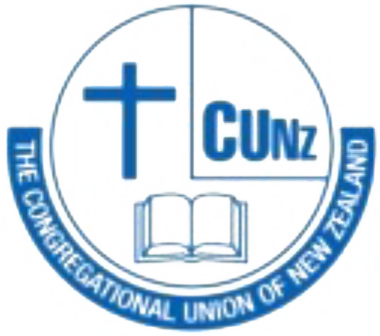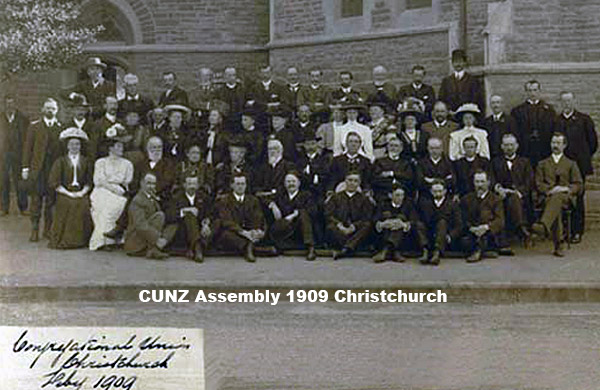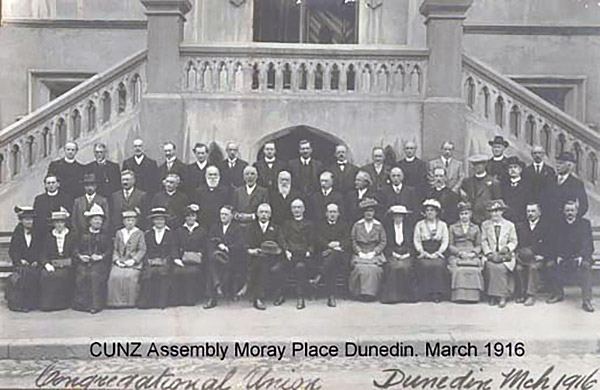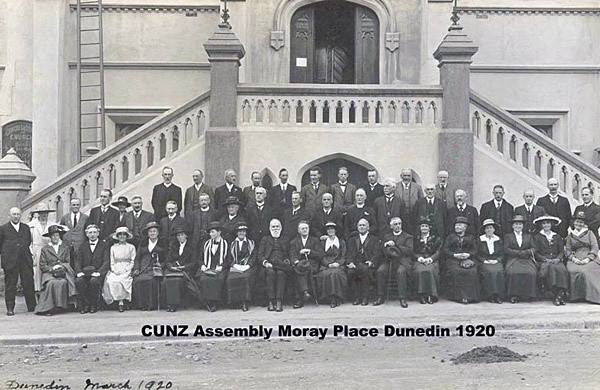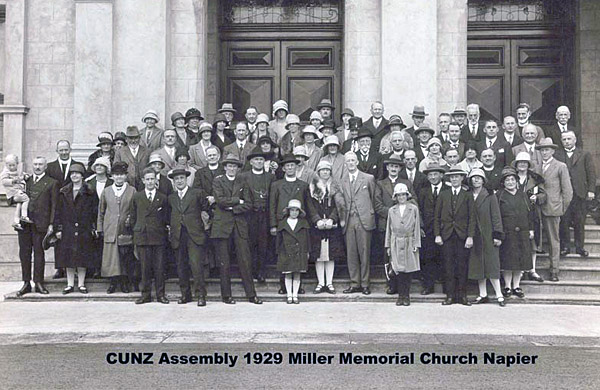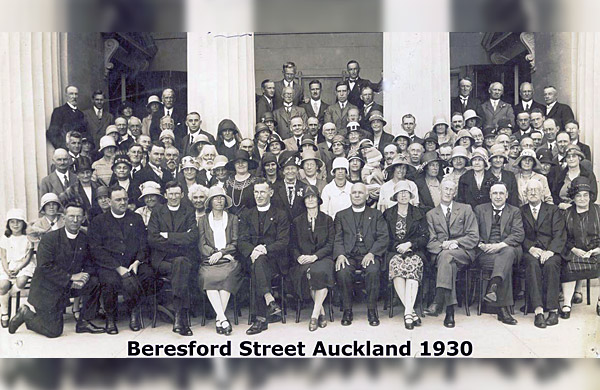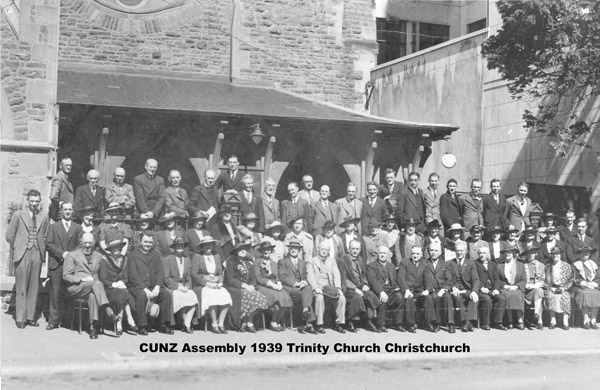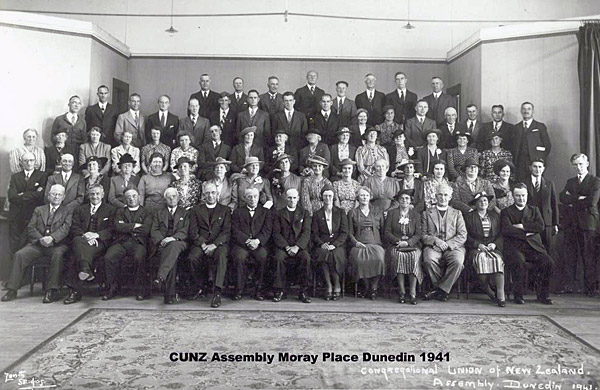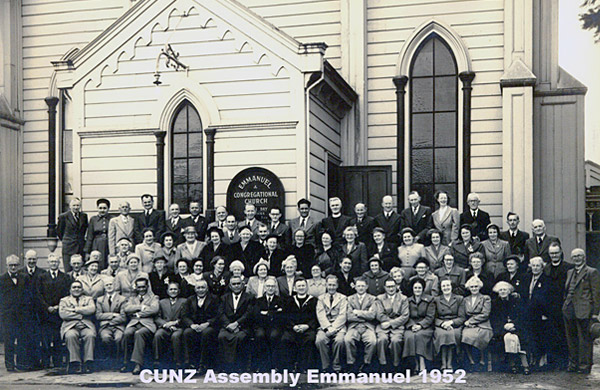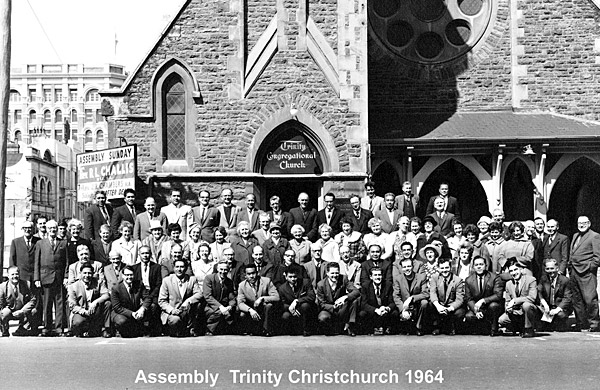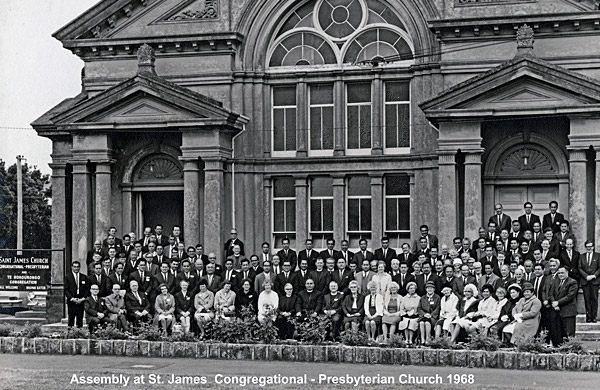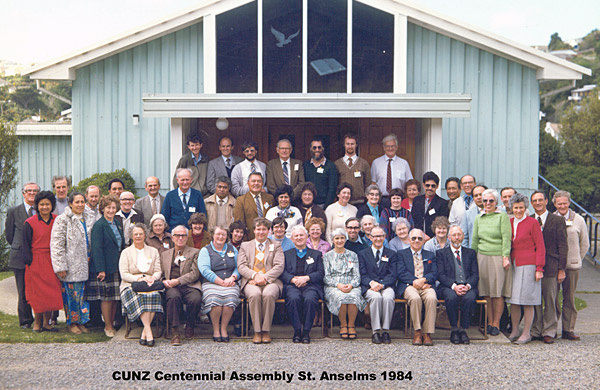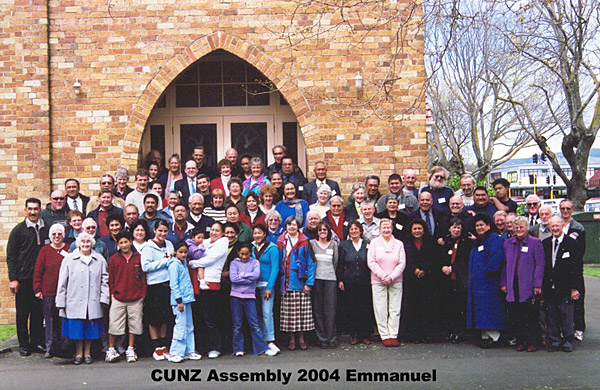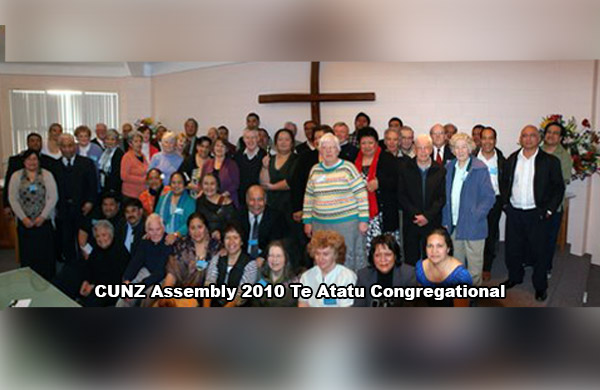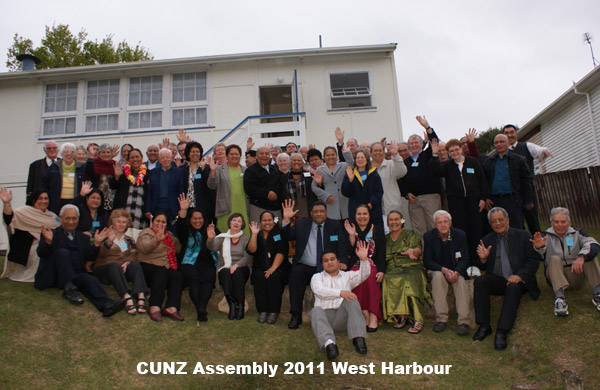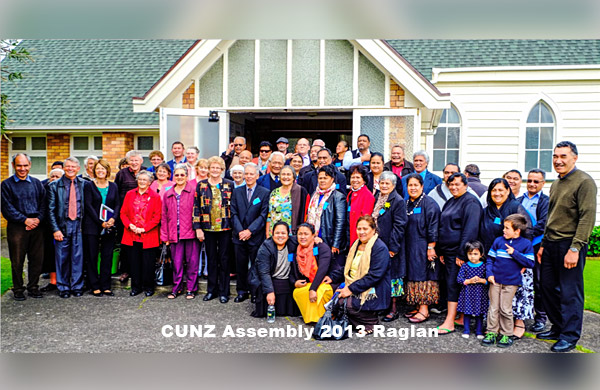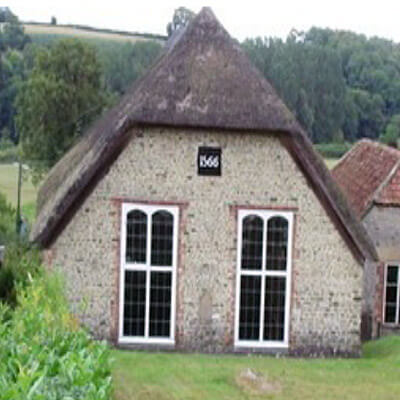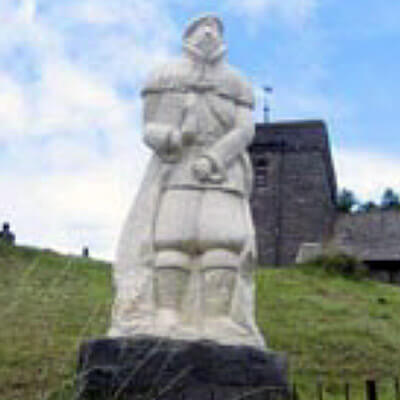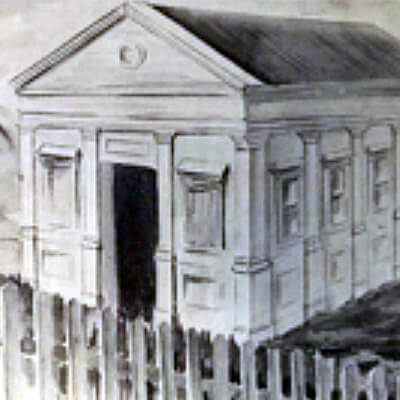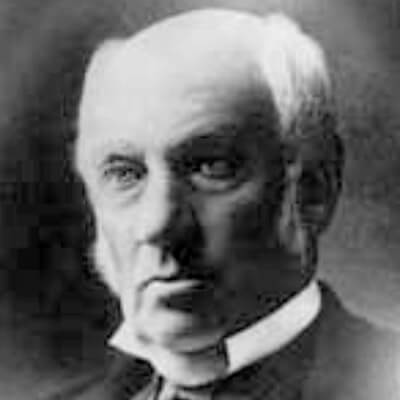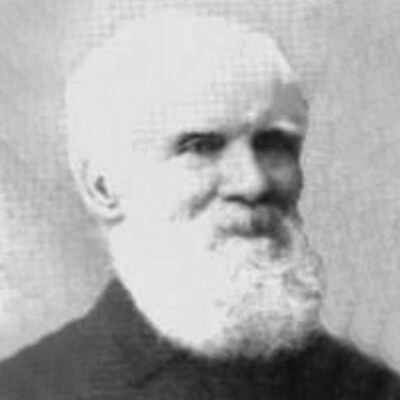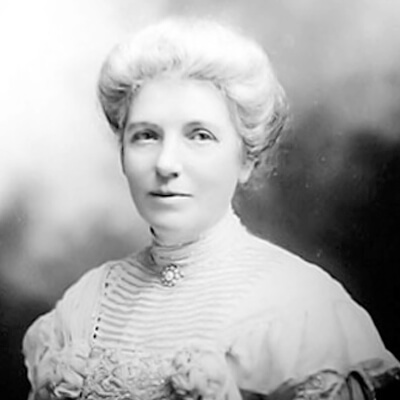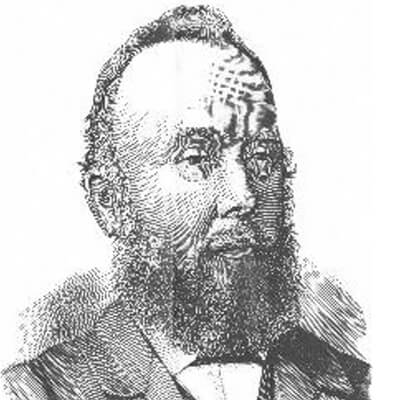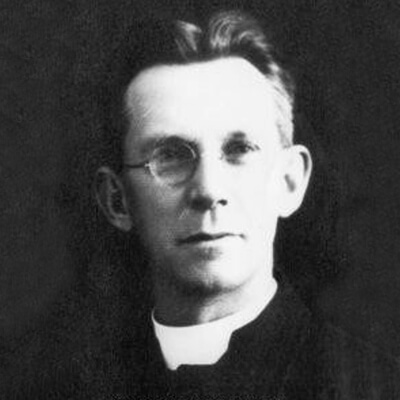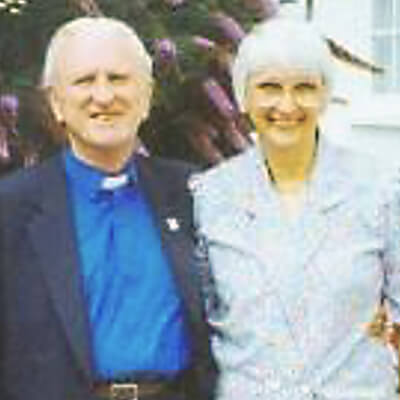The Congregational Union of New Zealand
OUR HISTORY
Since 1840
Congregational churches have been established in Aotearoa New Zealand.
Although not associated with any Missionary Society, Rev Barzillai Quaife became the first Congregational minister to settle in New Zealand, commencing in the Bay of Islands in 1840. A firm advocate for the Maori people, his outspoken views brought him into conflict with the ruling powers, especially as his views were spread in a newspaper he published.
Assembly Gatherings
1909 – 2013
English Origins
History by Hugh Neilson
What we now know as Congregationalism has its roots in the Reformation in England. Many devout Christians were concerned that the reforms then taking place in the English church were far from thorough. In the 1560’s several groups of individuals were meeting together. They saw that the Church did not consist of those living within the Parish bounds of a local building or any other geographic boundaries. The Church consisted of those true believers that met together for worship, prayer, praise, and instruction. Believing in the priesthood of all believers, and recognising that Christ alone was the Head of the Church, they rightly concluded that such groups were independent of any external authority.
Richard Fitz was the pastor of such a group of about 100 gathering in London in 1567. Their views did not find favour with either the ecclesiastical or civic rulers who classified them as ‘Separatists’ or ‘Dissenters’. As such they were believed to be a threat to the authority of the Queen. Fitz and most of his congregation were imprisoned and some, along with Fitz himself, were executed.
Horningsham Congregational Church
Built in 1566 is the oldest non-conformist church in England and is still in use today. The weekly services still use the ‘Congregational Praise’ hymnbook.
The Statue to the martyr John Penry
1563 – 1593 in St Cadmarch’s Church
Llangammarch, Wales.
Persecution did not kill the new movement, but the harsh laws caused many to take refuge in Holland. Later on Congregationalists seeking out life in a place where they could worship God according to their own understanding of the Bible included those those we now call ‘The Pilgrim Fathers’ who went to America.
A number of the Puritans were Congregationalists, although ‘Independent’ was the preferred term. John Owen ‘The Prince of the Puritans’, Thomas Goodwin and John Bunyan being some of the ones better known today. In different fields of endeavour, but still motivated by their strong religious beliefs, were Oliver Cromwell and the poet John Milton — also in the 17th Century.
The following century saw folk like Isaac Watts, ‘The Father of English Hymnody’ in England and in America Jonathan Edwards the great preacher and theologian who played a key role in the Revival of the times, spring to mind. The works of both these folk are still extensively read and sung to this day.
In 1658 delegates from over 100 churches met together at the Savoy in London and drew up two documents foundational to historic Congregationalism “The Savoy Declaration of Faith and Order” along with “The Institution of Churches and the Order Appointed in them by Jesus Christ.” Anyone who wishes to understand Congregationalism must study these documents. The Savoy Declaration is in most places identical to the Westminster Confession of Faith drawn up in 1643, by a committee appointed by Parliament.
The following century saw folk like Isaac Watts, “The Father of English Hymnody” in England while in America, Jonathan Edwards the great preacher and theologian (considered even by secular historians as the greatest mind America has ever produced) who played a key role in the Revival of the times known to history as The Great Awakening, spring to mind. The works of both these writers are still extensively read and sung to this day.
In the 19th Century, Congregationalists were very active in overseas mission work, principally through The London Missionary Society, (LMS) formed in 1795 and although originally interdenominational, became largely Congregational due to the formation of denominational Missionary Societies by the Anglican and Presbyterian Churches. David Livingstone in Africa, Robert Morrison in China and John Williams in the Pacific, being some of the brightest lights of that century.
New Zealand Planting
Early Years
Although not associated with any Missionary Society, Rev Barzillai Quaife became the first Congregational minister to settle in New Zealand, commencing in the Bay of Islands in 1840. A firm advocate for the Maori people, his outspoken views brought him into conflict with the ruling powers, especially as his views were spread in a newspaper he published. This work closed when he went back to Australia in 1844.
The next Congregational minister to arrive was Rev Horatio Groube who commenced services in a raupo whare in New Plymouth in February 1842. Although a church was eventually built, the cause did not last long, so the origins of Congregationalism in New Zealand are normally traced back to a Mr Jonas Woodward who commenced services in his home in Wellington in 1842. Under various names the Church formed from this little group exists today. The first Congregational Church at Auckland was formed in 1851, Dunedin in 1862 and Christchurch in 1864.
Woodward St. Congregational Church Wellington.
This is the earliest picture of a Congregational Church in New Zealand. Built in 1849.
There was a definite vigour in the churches in the new colony. For example the census for the Auckland Province, taken early in 1871, less than 10 years after the formation of the first Congregational Church was formed there, gives the total number of Congregationalists as 1,615, the fourth largest Protestant denomination. The National Census for 1874 gives the number of Congregational Independents in New Zealand as 5,441.
During this time many Churches sprang up all around New Zealand not only in the main centres but also in many very small settlements, and over the years these Churches were spread from Kawhia in the north to Invercargill in the south, from New Plymouth in the West to Gisborne and Napier in the East. Being independent, Churches could be formed wherever there were a few believers who wished to worship God according to Congregational principles without asking any outside authority.
Mr Jonas Woodward.
Founder of the first Congregational Church in Wellington from 1842-1859.
Along with the strong feeling of Independency there was also a definite felt need for fellowship with others of like mind, so in 1863, the Auckland Congregational Union and Mission was formed to serve the needs of the North Island Churches, with the exception of Wellington.
In January 1882 the Congregational Union and Mission of South New Zealand was formed in Dunedin. This Union covered all the South Island and Wellington. This apparently strange division was made because most long-distance travel then was done by boat, and it was far faster to get from Wellington to Christchurch or Nelson, than to Auckland. The same year the Southern Union decided to send one of its ministers Rev E Walker to England to try to raise funds amounting to £15,000 to be expended in (1) procuring sites for future churches and a Theological College; (2) assisting to liquidate church debts; and (3) helping Ministers opening up new spheres of labour. Unfortunately the Churches in England, while very sympathetic, were at the time themselves raising funds for an Anniversary project for the English Congregational Union, so success was very limited. But looking at the detail that they went into their passion for getting more, and well-trained people to go into the smallest of settlements to preach the gospel, shines brightly.
One year later it was moved that the title and constitution of the Southern Union be altered so that the Auckland Union could combine. This finally took place in Wellington from February 21-26th 1884, when The Congregational Union of New Zealand (CUNZ) held its first meeting.
The main document that came from this Union, was “The Congregational Union Incorporation Act” usually referred to as The Act of Incorporation. This is a legal document and the doctrinal part (Schedule C) is very basic and designed “simply as supplying safeguards for the preservation of church property to the Congregational body.” Over the years a need was felt for a more comprehensive statement and in the latter part of the 20thCentury, the much fuller Statement of Faith of the “Evangelical Fellowship of Congregational Churches” in the UK was adopted as an official statement of doctrine.
One activity of the CUNZ was buying up sections in places for proposed future Congregational Churches, and then doing their best to assist them to be formed. Some understandably, were never used. It is also worth noting here that in the early days virtually all ministers came either from England or Australia, and many returned, finding the rather rigorous conditions, even in the main centres, not conducive to either the good of their health or their children’s education.
Although there were a number of churches, many were very small and did not survive long. The reasons for this are no doubt many and varied, but in his Chairman’s address to the CUNZ in 1892 Rev W J Habens said, “It is not our fault that our churches at home have not sent out a greater stream of emigrants. Our original inferiority in numbers was so marked that by the time a dozen Congregationalists could be found to form the nucleus of a congregation, three or four congregations of a hundred and twenty in each could be gathered, under different names, in the same neighbourhood.” In spite of this Churches were to be found in rather unlikely places, and in some e.g. Taumarunui, a Congregational Church was the first to be established, while in others, such as Whangarei, folk who were solidly Congregational in principle, took a leading part in Presbyterian Churches until such time as a Congregational one was established.
Never large in numbers, Congregationalists in N Z have nevertheless always had an influence well out of proportion to their numbers. From the very early days they seem to have been very active in various groups such as The Bible Society, Hospital and Prison Chaplaincy. They were also heavily involved in inter-denominational evangelistic events, as well as various educational institutions. The churches generally have taken outreach seriously, not necessarily by forming new churches, but by evangelising the neighbourhood of the members.
Some Notable New Zealand Congregationalists
Rev Thomas Hamer arrived in Auckland in 1851 and was responsible for forming the second Congregational Church in Auckland originally known as the Albert Street (later Beresford Street) Church. It was largely due to his vigorous work in 1854, that the proposal by the Provincial Council that Bishop Selwyn’s stipend of £600 be paid by a grant from the Council, was defeated. He was very active in Evangelistic efforts in many groups including the “Open Air Service Association,” and was also a very regular and highly valued visitor to both the hospital and the gaol.
Kate Sheppard 1847-1934 the well-known activist for Women’s Rights (whose image is on our $10 note) was a member of Trinity Congregational Church in Christchurch.
Rev W J Habens, while still pastor of Trinity Church Christchurch, held a number of important local educational positions. He relinquished his pastorate in 1877 on being appointed to the Wellington based full-time position of Inspector-General of Schools and later became the Secretary for Education. He also became a member of the Senate of the University of New Zealand. These posts he held until his death in 1899. In Wellington he was a highly esteemed member of the Terrace Congregational Church serving as both a deacon and Sunday School Superintendent.
Mr George Hogben MA from the Timaru Church succeeded Rev Habens as Inspector- General of Schools and Secretary of Education, from 1899-1905, and in 1915 became the first Director of Education. He was awarded the CMG for services to Education.
Mr (Sir) George Fowlds, was a prominent Auckland businessman and a member of Beresford Street Church, Auckland. After entering politics he held many important portfolios. He was Chairman of Auckland University College for 13 years, and was also instrumental in the foundation of Massey College Palmerston North of which he was Chairman for many years. He was awarded the CBE then knighted in 1928.
Mr H E Shacklock, (1839-1902) was one of the original members of the Moray Place Church in Dunedin, and is best known because of the fine “Orion” coal range, he designed and manufactured specifically for use with the low grade of coal most common in New Zealand. After his death the firm of H E Shacklock continued to make these and also made the first electric oven in NZ in 1925; eventually being bought out by Fisher and Paykel.
Rev Lionel B Fletcher, came from Australia to minister at Beresford St. Church in Auckland from 1924 -1932. Under his ministry the church expanded greatly and for a while they had to hold their services in the Majestic Theatre due to the size of the congregation. Many young men from there trained for the Congregational Ministry, and others took a leading part in new Church planting. Some of these Churches are still functioning today. He was possibly the first minister in New Zealand to Broadcast Church Services, being a frequent broadcaster. He used the name ‘Uncle Leo’ when talking to children. In September 1932 he was appointed “Empire Evangelist” for the London based Movement for World Evangelism. He was also the author of several books on Christian life and witness, some of which are still in print.
Rev Dr J B Chambers OBE. MA. SPhD deserves special mention for several reasons. Not only did he hold several pastorates in his 42 year ministry, but seven years after his “retirement” he again assumed pastoral responsibility for the Cambridge Terrace Church, Wellington. Jim was also the longest serving Chairman of the CUNZ. He served in this capacity in 1952, 1966, 1967, 1969 – 1978, 1982-1996. A life member of the Union Jim was appointed Chairman Emeritus in recognition of his long service to the Union, including the difficult period following 1969, when most Churches of the CUNZ joined the Presbyterians. Rev Chambers also wrote “A Peculiar People” a 388 page Centennial History of Congregationalism in New Zealand. Outside of the CUNZ he had many interests including the “Order of St. Luke” and the Marching Girls Association. His wife Marcelle, also a life member of the Union was Secretary of the CUNZ for 14 years from 1971-1974.
Other Developments
Because of the early mission work of the London Missionary Society a lot of folk from many Pacific Islands look to Congregational Churches as their ‘home’ Church along with those of other races. The strength of the ties can be seen as the Foundation stone of the Devonport Church was laid by the Queen of Rarotonga on October 24 1885. Over the years these ties developed greatly, and at one time the number of churches and the number of members of the various Island churches associated with the CUNZ was by far the greatest percentage. After the events of 1969 this suddenly ceased to be the case, but over recent years the trend is going back to that state.
In 1969 there was a major division in the CUNZ with the majority of congregations and ministers opting to choose membership in the Presbyterian Church of New Zealand. The initially reduced numbers made fulfilling all obligations harder, but have brought out the very real dedication, which from the earliest days has been a feature of Congregationalism. There are now more churches than there were immediately post 1969 and most have a very good number of people in the younger age groups.
“This is the church of my dreams.”
In addition to the information above, taken from numerous Congregational Union of New Zealand sources, Dr Jim Chambers in his book “A Peculiar People”, quotes the front page of “The New Zealand Congregational Monthly” which certainly sets out well the ideals we have for our Churches under the heading “This Is The Church Of My Dreams”.
A Church adequate for the task. The Church of the warm heart, Of the open mind, Of the adventurous spirit: The Church that cares. That heals hurt lives. That comforts old people; That challenges youth; That knows no divisions of culture or class; No frontiers, geographical or social; The Church that inquires as well as avers, that looks forward as well as backward. The Church of the Master, The Church of the People, The high Church, the broad Church, the low Church. – high as the ideals of Jesus, low as the humblest human; A working Church, A worshipping Church: A Church that interprets the truth in terms of truth; That inspires courage for this life and hope for the life to come; A Church of courage, A Church of all good men THE CHURCH OF THE LIVING GOD.
The closing words of the Epilogue of this book present us with a permanent challenge.
The Congregational Union is made up of Churches. The Churches are made up of People. The Future of Congregationalism is in the hands of the individual Christians in a Congregational Church. The possibilities are immense for future expansion: the possibilities are also frightening for decay and annihilation.
Remember, in Christ – if you are in Christ “You are a chosen generation, a Royal Priesthood, an Holy Nation; a Peculiar People; that you should Show forth the praise of Him Who has called you out of darkness into His marvellous light” (1 Peter 2:9).
THANKS BE TO GOD.
Historic Information Sources
A key source of historic data about the Congregational Union of New Zealand is: is H.F. Neilson’s CUNZ Archives, deposited in the Alexander Turnbull Library.
Additional information comes from the Year Books of the Congregational Union of New Zealand. CUNZ has almost a complete set of year books going back to the 1800’s.
Chambers, Rev. J. B., A Peculiar People: Congregationalism in New Zealand 1840—1984 (Wellington: Congregational Union of New Zealand 1984).
